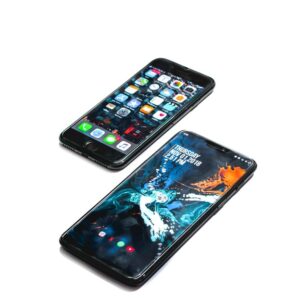Testing on Real Devices or Emulators: What’s Better for Startup?

Managing device fragmentation through testing is one of the main worries of the development team and the quality assurance team when developing a new app or thinking about porting one from Apple to Android. They want to know if using emulators can do the same or better than testing on actual devices because so many devices are available.
When testing devices, especially for UI and functional tests, device fragmentation is a real issue. Even if the OS fragmentation issue is significantly improving, the Android market still has hundreds of different manufacturers.
Today, we can say that there are more smartphones with distinctive specs and proprietary build modifications. While there are many older versions still available, Apple has less choice. This indicates that Android takes a little more attention for testing purposes, but it doesn’t negate the value of testing actual iOS devices. The number of devices is too large for emulators to be your only option.
Table of Contents
Testing with emulators and simulators
There are a few great reasons to consider emulators as your primary testing choice if you’re a small business startup on a budget. With over 20 thousand different devices available, one of the main reasons why many organizations choose emulators or simulators over actual devices is the cost of purchasing enough. Emulators frequently cost nothing to use or have a minimal monthly user fee. In contrast to even a single device, let alone an entire test lab of equipment, even paid options are quite affordable.
The fact that several of the frequent UI issues that urged for real device testing have been mitigated or fixed is another reason emulators have been used a little more recently. One of these is screen size. Android devices continue to come in a wide variety of screen sizes. Issues with the screen and visual display are less frequent. Theoretically, if something appears in the emulator and is tested across a variety of display sizes, it should also appear on the actual device. However, the issue with mimicked testing was never the main one.
Additionally, some components, such as launching web apps through URL, may be simpler to test on an emulator. The test can be carried out using an emulator by copying and pasting. Typing on the touch screen is normally done on a real device.
Since they are already on your computer, taking screenshots of UI or display problems from an emulator can be simpler. On both platforms, there are numerous third-party applications available for this purpose.
An emulator can also extract data in real-time and update reports as it runs, giving the development team the information they need to troubleshoot problems.
As a result, emulators have a position in the testing industry. Let’s examine the causes for this.
Using actual iOS and Android devices for testing
While an emulator is ideal for initial testing while developing, particularly for iterative tests of small bits of code, it is insufficient for the final testing of a product because it can’t possibly test all that needs to be tested. Testing using actual mobile phones consistently produces accurate findings for the target device, free of false positives or negatives. Real device testing makes sense from a logical perspective because it is the only way to ensure that a feature will function on a specific device.
Usually, a modified OS will be running on your emulator. It implies that the basic distinctions between vendors and carriers might not be sufficiently addressed. Over the top of the basic OS, carriers and vendors alike add interface layers, skins, and other middleware. Sometimes the device maker and the carrier both add layers. It may result in an additional layer of fragmentation that an emulator cannot handle.

Difficulties with the chipset, memory, and other hardware
Emulators fall short in testing memory problems, which are rife in app testing. One issue is that developers frequently concentrate on the best smartphones and create software to amaze people on these platforms. Unfortunately, this frequently results in widely used devices that have poorer performance being unable to manage these variations. Because it does not consider other processes and activities that can be active on a low-end device, an emulator with resources set aside just for executing the app will frequently report that everything is great.
Chipset
As we have noted, the number of device configurations has expanded significantly in the past year, with over 3000 more variants being found this year than last. It is safe to say that out of 20 thousand different Android smartphones, some permutations are bound to occur, even though not all of these have noticeably different chipsets, display sizes, sensors, or other hardware changes. Because the CPU of the PC they operate on is 10 times more powerful than the processor of a specific android device, chipsets in particular can offer users experiences that are dramatically different between high and low-end devices. Despite this, they can completely mislead an emulator. The emulator can unintentionally borrow to complete the task despite these limitations.
Battery
The battery is another element of a physical phone that an emulator cannot check. Simply said, there is no way to use an emulator to test your program’s effectiveness and power usage. The success of an app that destroys your phone in one hour is unlikely.
Sensor
Emulators are just unable to test for many sensor concerns. Some sensor functionalities, such as push notifications, geolocation, orientation, and other functionality, cannot be effectively tested without a genuine device. However, Android and iOS emulators can test them (with some restrictions). A genuine gadget is also needed for NFC and other features.
Interruption
One of these is being interrupted by calls, messages, or push notifications. Emulators fail to accurately simulate how your application will respond to such network-related events. Another is the contrast between touchscreen interactions and mouse and keyboard interactions. With a touch screen, pinching the screen to make a view smaller or spreading your thumb and forefinger to make a view larger will feel very different.
Look and Feel
In general, an emulator cannot effectively simulate the look and feel of the app. Emulation will not allow you to assess the application’s responsiveness on a specific phone. Other potential areas of worry are the display’s brightness and if the color scheme looks good in natural light.
Real-world Device Testing Challenges
Cost
Many startups generally do not have the resources to purchase a sufficient number of devices to adequately represent the market for automated or one-to-one testing. Any real device testing is better than none at all. Emulators are a practical and affordable tool for testing mobile devices, and they unquestionably have a role in developing apps. However, there is no substitute for an actual gadget for a realistic evaluation of user experience and a thorough investigation of functioning.
Logistics
Real devices are expensive, and storing and running tests on them present logistical challenges. Testing on actual devices must be done manually because there is no method to test numerous devices simultaneously. Even if you can test numerous devices simultaneously on an automated platform, it will still take up a lot of space. Even testing 5 gadgets might leave your desk rather cluttered. Other complications include making sure the correct cord stays with the correct device.
Another problem with automating testing is that each device might be configured to connect to the platform. Additionally, you need to plan out how they will all charge. Your organization will incur a higher time and labor cost the more devices these tasks need to be completed.

Reducing these problems
If you can’t afford a good test lab, one option is to have employees buy various devices for personal communication and encourage later-stage app testing. Remember that no one will want to be forced to use a subpar device, so this solution might not be typical.
Startups and larger enterprises might get the assistance they need from a software QA outsourcing company TestFort to decrease the worries above. With such a service, you can quickly and easily design and run dozens of functional automated tests on more than one hundred devices. You can obtain a fantastic and repeatable overview of your essential requirements, which can reduce the hazards associated with unavailable devices.
Summary
We as a QA testing team are fully aware of the importance of real device testing. No matter how many enhancements are made to emulators, Android’s code base, or developer instructions, real device testing is a crucial step in creating apps, and don’t skip it. Users are intolerant of mistakes and can identify when corners have been cut. Do not get intimidated by the variety of devices available; even with a small selection, you will still create better software than you would have if you had not tested actual devices. Outsourced testing might be your best option if you cannot purchase a sample size of actual devices to test your application.
Also Read: Why Can’t PS5 Play PS4 And PS3 Games?




